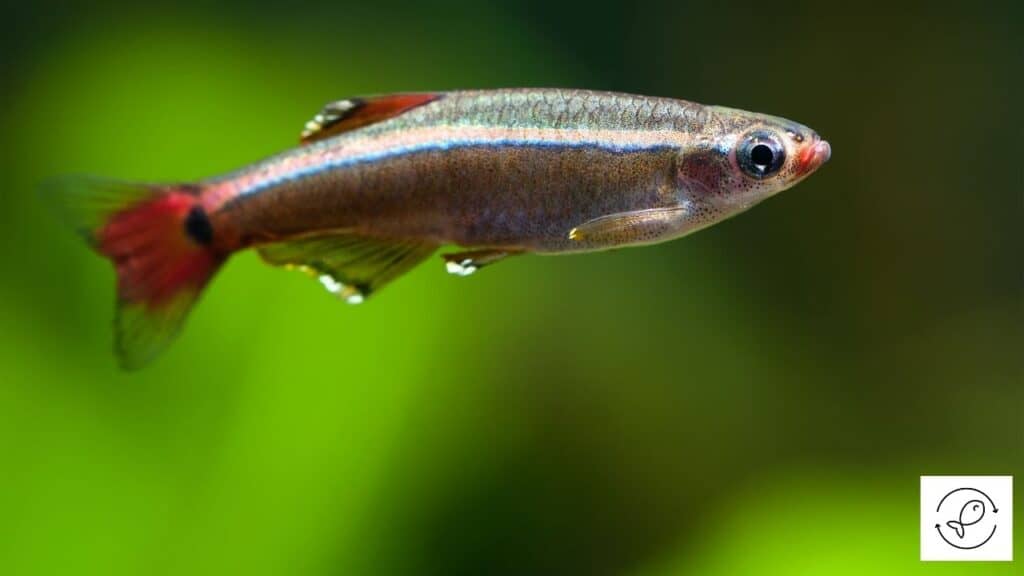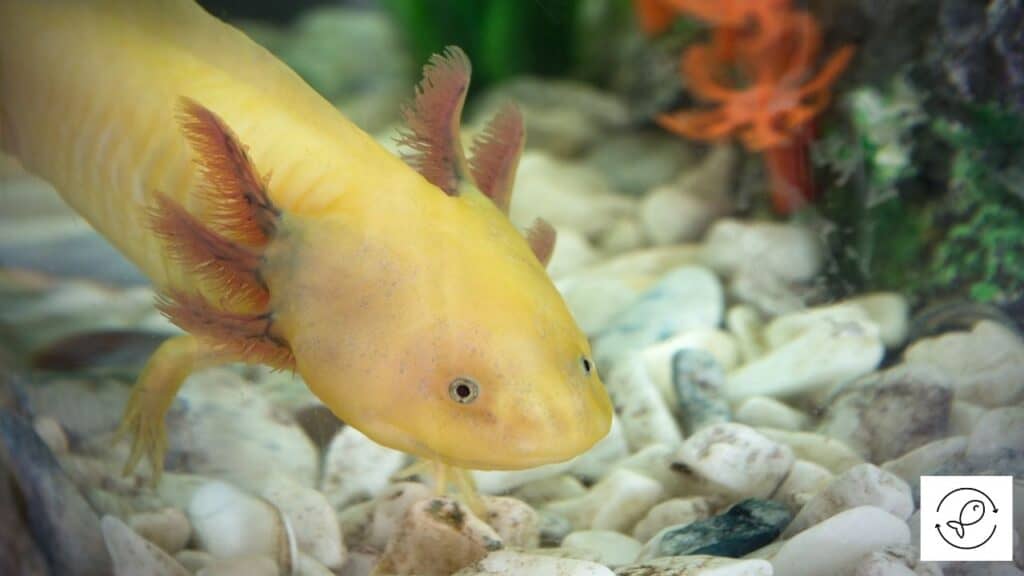Axolotls can live with freshwater fish and crustaceans. However, either the axolotls will eat the small fish or choke while swallowing a big fish. It’s best to keep axolotls alone to reduce the risk of infections, degraded water quality, and the fish’s impact on their overall health and longevity.
Let’s now understand the risks of keeping axolotls with fish in more detail.
What Are The Risks Of Keeping Axolotls With Fish?
You can keep axolotls with freshwater creatures. However, there are challenges and risks involved in this.
So, it’s better to evaluate all the risks before selecting the tankmates for your axolotl.
Given below are some of the risks of keeping axolotls with fish.
1. Bites And Infections
Some fin-nipping fish will bully your axolotl by nipping its fins and gills.
However, it’s not that big of an issue. An axolotl can regenerate gills and other body parts.
The real challenge is the fungal infections caused due to such injuries.
These can allow parasites into the water, making the axolotl weak and even resulting in its premature demise.
2. Parasites
Many axolotl owners use live fish as feeder fish for their pet axolotl. Moreover, live fish can introduce harmful parasites in the tank.
These harmful parasites can stress the axolotl and eventually make it weak and ill.
So it’s necessary to quarantine the fish before adding them into the axolotl tank.
3. Choking Or Congestion
The axolotl can try to swallow bigger fish, leading to choking and demise.
Besides, if the axolotl eats the fish or snails with sharp exoskeletons, it can cause congestion in their gut.
If the shells are too sharp, they can even damage their gut and be fatal.
4. Stress
Some fish are skittish in behavior, making rapid movements across the tank.
Axolotls can get stressed quickly by these sudden flashy movements of the fish.
Bottom feeders can also get into direct competition with your axolotl, resulting in stress, which can eventually be fatal.
To ensure the health and well-being of your axolotl, it’s better to keep it alone to provide a stress-free environment and improve its chances of survival.
Do Axolotl Eat Fish?
Axolotls are carnivorous species. So they will devour small fish, crustaceans, and other invertebrates that they encounter inside the fish tank without any hesitation.
Axolotls are not picky eaters and will see small tankmates as their meals.
Unfortunately, axolotls will also go after large fish or crustaceans, even the ones that they can’t swallow completely.
This can lead to problems like choking.
Axolotls are prone to choking on food that is too big to pass through their GI tract.
The food can get stuck at an angle that doesn’t allow the axolotls to gulp it, leading to choking.
So it’s imperative to consider all the pros and cons before selecting tankmates for your axolotl.
6 Tankmates That You Can Keep With Axolotls
Axolotls are exotic species that can live alone in the tank.
There aren’t many fish that you can keep in the same tank with an axolotl without harming it.
Given below are six species that you can safely keep with axolotls.
1. Axolotls
Axolotls can live with other axolotls. However, they aren’t social species, which means they can live alone.
If you want to house axolotls together, make sure they’re the same size.
Adult axolotls can make good tankmates. So you can keep a male and female axolotl together.
You can also keep axolotls of the same gender to avoid babies.
Avoid keeping young axolotls together as they often display cannibalistic behavior toward each other.
Also avoid keeping a small axolotl with a fully grown adult axolotl as it can end up being a snack.
2. White Cloud Mountain Minnows

The minnows are peaceful coldwater fish.
They are ideal tankmates for axolotls as they don’t have hard exoskeletons or sharp spins to pierce or injure the axolotl’s permeable skin.
These fish don’t pose any threat to axolotls. However, the axolotl can become a problem for the minnows.
They can devour the minnows without any hesitation.
Minnows are pretty fast and can race across the tank if they feel threatened.
However, they will get eaten if they’re caught off guard.
3. Guppies
Guppies are another fish species that aren’t likely to harm an axolotl.
They are small and don’t have a hard exoskeleton, which means axolotls can swallow them easily.
Baby guppies are often used as feeder fish for young axolotls.
This means aquarists intentionally feed these fish to their axolotls as they are small and don’t pose any risk if young axolotls swallow them.
Guppies are an easy meal for axolotls.
However, guppies reproduce very fast, and their fast-increasing numbers can be stressful for axolotls.
4. Zebra Danios
Zebra danios are docile, peaceful coldwater fish that you can keep with an axolotl.
The fish is social in behavior and will keep to their shoals. So they will most likely stay away from your axolotl.
However, fish in poorly maintained tanks are at a greater risk of diseases and premature demise.
Don’t be surprised if your fish begin to disappear from the tank.
Zebra danios are fast and can quickly escape an axolotl, but the axolotl will devour the unsuspecting danios.
5. Apple Snails
You can keep adult apple snails in the same aquarium with your young axolotl as they’re not too small for the axolotl to swallow.
Coldwater snails like young bladder or ramshorn snails are also safe because of their soft shells.
Adult ramshorn snails and bladder snails aren’t recommended for an axolotl tank.
These snails are small, so your axolotl can swallow them quickly. However, they’re not soft enough for the axolotl to digest easily.
6. Shrimp
You can add freshwater shrimp to an axolotl tank. However, they shouldn’t be considered as tankmates for axolotls.
This is because of how quickly an axolotl will devour them.
Some fishkeepers use shrimp as treats for their axolotl.
Amano shrimp and ghost shrimp can be excellent additions to any freshwater aquarium.
These shrimp are best to clear detritus and other leftover food. So they can be a great help to maintain good water quality.
You can add aquatic plants for the shrimp to hide and take shelter.
However, the vegetation will not save the shrimp as axolotls have an excellent sense of smell.
Fish That You Can’t Keep With Axolotls
We aren’t trying to list all unsuitable fish or invertebrates for an axolotl tank as the list is very long.
Instead, we will cover the fish species that seem compatible with an axolotl at first glance.
However, they’re actually incompatible and can also cause problems to axolotls.
Given below are the fish species that are unsafe to keep with axolotls.
1. Goldfish
Goldfish have a terrible reputation for bullying axolotls. They tend to nip the fins and gills of axolotls, causing stress and injury.
Large adult goldfish can easily harass the slow-moving axolotls.
Goldfish also produce a lot of waste, which is not ideal when added to the already messy axolotl tank.
Young goldfish also pose a choking hazard to axolotls if they get swallowed.
So it’s best to keep both of them in separate tanks or get a huge tank to accommodate both species together.
2. Cory Catfish
Cory catfish are peaceful freshwater fish, but they aren’t compatible with axolotls.
These fish have sharp spines on their dorsal and pectoral fins.
If the axolotls try to swallow them, their sharp spines can pierce or injure the axolotl’s permeable skin.
Cory catfish are also bottom-feeders and will directly compete with the bottom-dwelling axolotls.
So this can create a lot of stress for the axolotls.
3. Otocinclus Catfish
Otocinclus catfish is another fish species that seems completely innocuous at first glance.
Unfortunately, they have spines like cory catfish, which can be dangerous for axolotls.
These fish are also sensitive to changes in water flow.
They prefer fast-moving water and move around the tank at high speeds.
Their rapid movements can be stressful for the axolotls.

